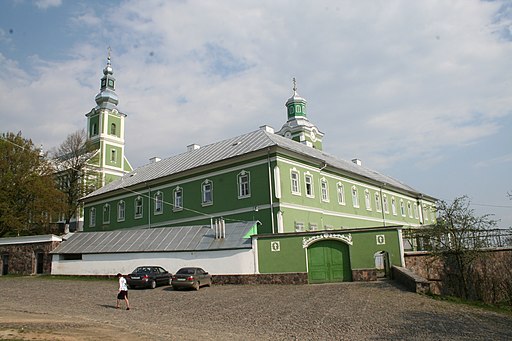Basilian St Nicholas Monastery on Mount Csernek
Свято-Миколаївський жіночий монастир
Basilian St Nicholas Monastery on Mount Csernek
Свято-Миколаївський жіночий монастир
Original function:
monastery / nunnery / canon's house / provost residence
Current function:
monastery / nunnery / canon's house / provost residence
Historical Hungarian county:
Bereg
GPS coordinates:
48.454949, 22.733688
History
The monastery on the Fekete-hegy (Black Hill) near Munkács is now a female Orthodox convent.
Some date it to the 11th century, when Orthodox monks from Kiev founded a cave monastery here. They came to Hungary with the wife of King Andrew I of Hungary, Anastasia, the daughter of Grand Prince Yaroslav of Kiev.
In 1396, after having betrayed Grand Duke Vytautas the Great, Prince Fyodor Koriatovych of Podolia fled from the Grand Duchy of Lithuania to Hungary He received the castle of Munkács and its surroundings from King Sigismund of Hungary as a fief. Along with the Ruthenians who accompanied him, monks also arrived who founded the monastery on the Black Hill.
According to a legend, Prince Fyodor was attacked by a snake during a hunt. He could only defeat it by calling St. Nicholas for help. Therefore, out of gratitude, he erected a monastery there in honor of the saint. The monastery was an important center of Slavic culture in Subcarpathia (which anyway was only a geographical and not an administrative unit until 1920).
The first documented mention of the monastery can be found in the charter of King Matthias of Hungary dated August 14, 1458.
In 1491 the monastery became the seat of the Eastern Orthodox Diocese of Munkács founded at the end of the 15th century. It burned down in the internal war in 1537, but was rebuilt.
In 1646, in the Union of Ungvár, the Eastern Orthodox Church in Hungary returned to the authority of the Pope and established the Greek Catholic Church. At that time the monastery joined the Greek Catholic Basilian monastic order.
The monastery was a wooden building until the 16th century. Its first stone church was built in 1661 in early Baroque style.
In 1751, under Bishop Olsavszky Mihály Manó, the Greek Catholic episcopal seat moved from the monastery to Munkács (it is located in Ungvár since 1780). Today's Baroque monastery building was built between 1766 and 1772, and its foundation stone was laid by Bishop Olsavszky Mihály Manó.
The Church of St. Nicholas was consecrated on August 27, 1859 by Bishop Popovics Vazul.
The monastery also had a school and a rich library. In 1946, the Soviets abolished the Greek Catholic Church and forcibly wanted to merge it into the Eastern Orthodox Church. The monks refused this one by one, so they were exiled. The monastery was then turned into an Orthodox female convent.
{"item":"sight","set":{"sightId":986,"townId":49,"active":1,"name_LO":"\u0421\u0432\u044f\u0442\u043e-\u041c\u0438\u043a\u043e\u043b\u0430\u0457\u0432\u0441\u044c\u043a\u0438\u0439 \u0436\u0456\u043d\u043e\u0447\u0438\u0439 \u043c\u043e\u043d\u0430\u0441\u0442\u0438\u0440","address":"Pivnichna St","mapdata":"3|802|220","gps_lat":"48.4549490000","gps_long":"22.7336880000","religion":4,"oldtype":"5","newtype":"5","homepage":"https:\/\/myk-mon.church.ua\/","openinghours":"","muemlekemlink":"https:\/\/www.muemlekem.hu\/hatareset\/Bazilita-kolostor-Munkacs-659","csemadoklink":"https:\/\/www.karpatinfo.net\/latnivalok\/csernekhegyi-bazilita-kolostor-munkacs","picture":"\u003Ca title=\u0022\u0413\u0443\u0434\u0430\u043a \u0410\u043b\u0435\u043a\u0441\u0430\u043d\u0434\u0440 \u041c\u0438\u0445\u0430\u0439\u043b\u043e\u0432\u0438\u0447 \/ CC BY-SA (https:\/\/creativecommons.org\/licenses\/by-sa\/3.0)\u0022 href=\u0022https:\/\/commons.wikimedia.org\/wiki\/File:%D0%9C%D1%83%D0%BA%D0%B0%D1%87%D0%B5%D0%B2%D0%BE_%D0%96%D0%B5%D0%BD%D1%81%D0%BA%D0%B8%D0%B9_%D0%BC%D0%BE%D0%BD%D0%B0%D1%81%D1%82%D1%8B%D1%80.JPG\u0022\u003E\u003Cimg width=\u0022512\u0022 alt=\u0022\u041c\u0443\u043a\u0430\u0447\u0435\u0432\u043e \u0416\u0435\u043d\u0441\u043a\u0438\u0439 \u043c\u043e\u043d\u0430\u0441\u0442\u044b\u0440\u0022 src=\u0022https:\/\/upload.wikimedia.org\/wikipedia\/commons\/thumb\/e\/e3\/%D0%9C%D1%83%D0%BA%D0%B0%D1%87%D0%B5%D0%B2%D0%BE_%D0%96%D0%B5%D0%BD%D1%81%D0%BA%D0%B8%D0%B9_%D0%BC%D0%BE%D0%BD%D0%B0%D1%81%D1%82%D1%8B%D1%80.JPG\/512px-%D0%9C%D1%83%D0%BA%D0%B0%D1%87%D0%B5%D0%B2%D0%BE_%D0%96%D0%B5%D0%BD%D1%81%D0%BA%D0%B8%D0%B9_%D0%BC%D0%BE%D0%BD%D0%B0%D1%81%D1%82%D1%8B%D1%80.JPG\u0022\u003E\u003C\/a\u003E","picture_ref":"\u003Ca href=\u0022https:\/\/commons.wikimedia.org\/wiki\/File:%D0%9C%D1%83%D0%BA%D0%B0%D1%87%D0%B5%D0%B2%D0%BE_%D0%96%D0%B5%D0%BD%D1%81%D0%BA%D0%B8%D0%B9_%D0%BC%D0%BE%D0%BD%D0%B0%D1%81%D1%82%D1%8B%D1%80.JPG\u0022 title=\u0022via Wikimedia Commons\u0022\u003E\u0413\u0443\u0434\u0430\u043a \u0410\u043b\u0435\u043a\u0441\u0430\u043d\u0434\u0440 \u041c\u0438\u0445\u0430\u0439\u043b\u043e\u0432\u0438\u0447\u003C\/a\u003E \/ \u003Ca href=\u0022https:\/\/creativecommons.org\/licenses\/by-sa\/3.0\u0022\u003ECC BY-SA\u003C\/a\u003E","name":"Basilian St Nicholas Monastery on Mount Csernek","note":"","history":"The monastery on the Fekete-hegy (Black Hill) near Munk\u00e1cs is now a female Orthodox convent. \nSome date it to the 11th century, when Orthodox monks from Kiev founded a cave monastery here. They came to Hungary with the wife of King Andrew I of Hungary, Anastasia, the daughter of Grand Prince Yaroslav of Kiev.\nIn 1396, after having betrayed Grand Duke Vytautas the Great, Prince Fyodor Koriatovych of Podolia fled from the Grand Duchy of Lithuania to Hungary He received the castle of Munk\u00e1cs and its surroundings from King Sigismund of Hungary as a fief. Along with the Ruthenians who accompanied him, monks also arrived who founded the monastery on the Black Hill.\nAccording to a legend, Prince Fyodor was attacked by a snake during a hunt. He could only defeat it by calling St. Nicholas for help. Therefore, out of gratitude, he erected a monastery there in honor of the saint. The monastery was an important center of Slavic culture in Subcarpathia (which anyway was only a geographical and not an administrative unit until 1920).\nThe first documented mention of the monastery can be found in the charter of King Matthias of Hungary dated August 14, 1458.\nIn 1491 the monastery became the seat of the Eastern Orthodox Diocese of Munk\u00e1cs founded at the end of the 15th century. It burned down in the internal war in 1537, but was rebuilt. \nIn 1646, in the Union of Ungv\u00e1r, the Eastern Orthodox Church in Hungary returned to the authority of the Pope and established the Greek Catholic Church. At that time the monastery joined the Greek Catholic Basilian monastic order. \nThe monastery was a wooden building until the 16th century. Its first stone church was built in 1661 in early Baroque style. \nIn 1751, under Bishop Olsavszky Mih\u00e1ly Man\u00f3, the Greek Catholic episcopal seat moved from the monastery to Munk\u00e1cs (it is located in Ungv\u00e1r since 1780). Today's Baroque monastery building was built between 1766 and 1772, and its foundation stone was laid by Bishop Olsavszky Mih\u00e1ly Man\u00f3.\nThe Church of St. Nicholas was consecrated on August 27, 1859 by Bishop Popovics Vazul. \nThe monastery also had a school and a rich library. In 1946, the Soviets abolished the Greek Catholic Church and forcibly wanted to merge it into the Eastern Orthodox Church. The monks refused this one by one, so they were exiled. The monastery was then turned into an Orthodox female convent.\n","town":{"townId":49,"name_HU":"Munk\u00e1cs","name_LO":"\u041c\u0443\u043a\u0430\u0447\u0435\u0432\u043e","seolink":"munkacs-munkachevo","oldcounty":21,"country":3}},"language":"en","region":"ukraine","regionid":3,"offer":[],"gallery":false,"album":false}

